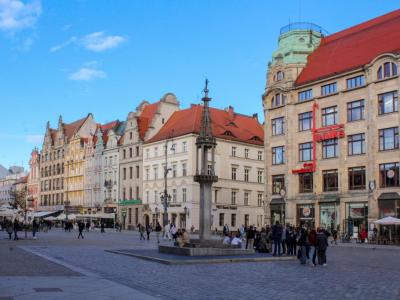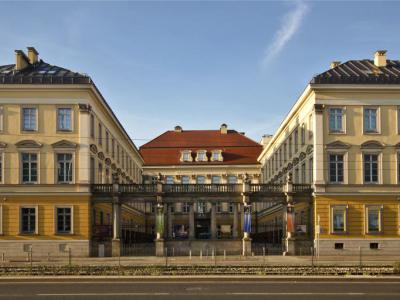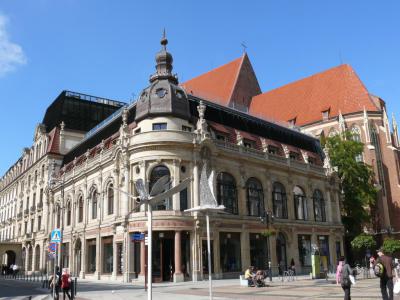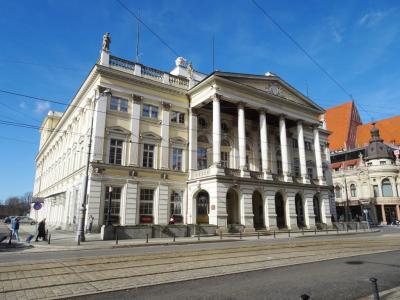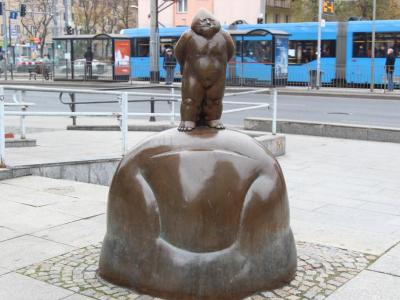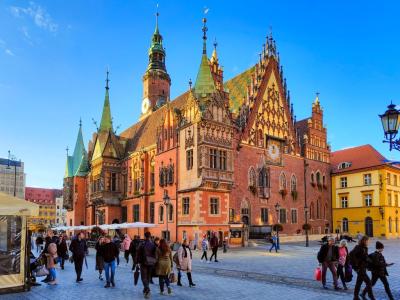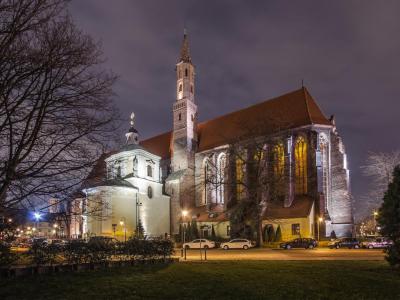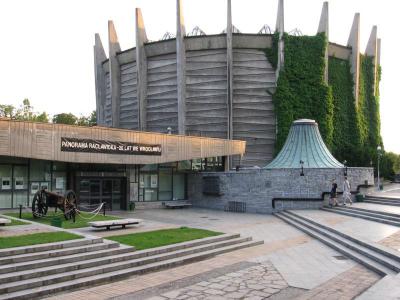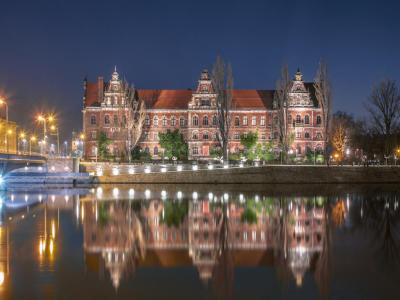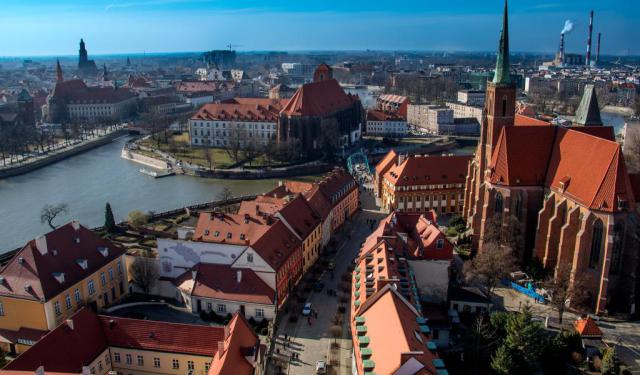
Wroclaw Introduction Walking Tour (Self Guided), Wroclaw
Wroclaw, the capital of Poland’s Lower Silesia province, is a travel gem for wandering hearts. Steeped in over 1,000 years of history and a vibrant blend of Polish, German, and other cultural influences, it could easily compete for the title of the most beautiful city in Europe.
The area around Wroclaw was inhabited as early as the 9th century by Slavic tribes. The town was originally part of the Duchy of Poland and later the Kingdom of Poland.
In the Middle Ages, Wroclaw became a prominent trading and cultural center within the Holy Roman Empire. The city changed hands several times between the Kingdom of Bohemia, the Kingdom of Prussia, and the Habsburg Monarchy of Austria during the 17th and 18th centuries.
In the 19th century, Wroclaw became part of Prussia and then the German Empire. During this time, it underwent significant industrialization and urban development. Back then, it was known as Breslau – the name it bore until 1945.
After World War II, Wroclaw was returned to Poland as part of the post-war territorial changes. The city's German population was expelled, and it was repopulated with Poles.
The name "Wroclaw" is believed to be an abbreviation of the Old Polish name "Wrocisław", which is a compound word. The first part of it means "to return", and the second part ("slav") means "reputation" or "fame".
Today, Wroclaw is one of the country's major cultural, economic, and academic hubs. It is known for its picturesque Old Town, diverse architecture, and vibrant cultural scene.
At the heart of the city lies the picturesque Market Square (Rynek), one of Europe's largest medieval squares. Surrounded by colorful historic buildings, it's a lively spot not to be missed. The square's centerpiece, Wroclaw Town Hall, is a masterpiece of Gothic architecture and an iconic symbol of the city.
As you stroll along the pretty streets, you cannot help noticing sculpted dwarfs here and there! These charming figurines – there are over 200 of them scattered throughout the city – add a touch of whimsy to your exploration. Each dwarf has its unique personality and backstory, making for a delightful scavenger hunt.
In Wroclaw, history, culture, and modernity coexist harmoniously, inviting travelers to explore its multifaceted charm. Plan your journey today and venture out on this self-guided walk. Wroclaw awaits your discovery!
The area around Wroclaw was inhabited as early as the 9th century by Slavic tribes. The town was originally part of the Duchy of Poland and later the Kingdom of Poland.
In the Middle Ages, Wroclaw became a prominent trading and cultural center within the Holy Roman Empire. The city changed hands several times between the Kingdom of Bohemia, the Kingdom of Prussia, and the Habsburg Monarchy of Austria during the 17th and 18th centuries.
In the 19th century, Wroclaw became part of Prussia and then the German Empire. During this time, it underwent significant industrialization and urban development. Back then, it was known as Breslau – the name it bore until 1945.
After World War II, Wroclaw was returned to Poland as part of the post-war territorial changes. The city's German population was expelled, and it was repopulated with Poles.
The name "Wroclaw" is believed to be an abbreviation of the Old Polish name "Wrocisław", which is a compound word. The first part of it means "to return", and the second part ("slav") means "reputation" or "fame".
Today, Wroclaw is one of the country's major cultural, economic, and academic hubs. It is known for its picturesque Old Town, diverse architecture, and vibrant cultural scene.
At the heart of the city lies the picturesque Market Square (Rynek), one of Europe's largest medieval squares. Surrounded by colorful historic buildings, it's a lively spot not to be missed. The square's centerpiece, Wroclaw Town Hall, is a masterpiece of Gothic architecture and an iconic symbol of the city.
As you stroll along the pretty streets, you cannot help noticing sculpted dwarfs here and there! These charming figurines – there are over 200 of them scattered throughout the city – add a touch of whimsy to your exploration. Each dwarf has its unique personality and backstory, making for a delightful scavenger hunt.
In Wroclaw, history, culture, and modernity coexist harmoniously, inviting travelers to explore its multifaceted charm. Plan your journey today and venture out on this self-guided walk. Wroclaw awaits your discovery!
How it works: Download the app "GPSmyCity: Walks in 1K+ Cities" from Apple App Store or Google Play Store to your mobile phone or tablet. The app turns your mobile device into a personal tour guide and its built-in GPS navigation functions guide you from one tour stop to next. The app works offline, so no data plan is needed when traveling abroad.
Wroclaw Introduction Walking Tour Map
Guide Name: Wroclaw Introduction Walking Tour
Guide Location: Poland » Wroclaw (See other walking tours in Wroclaw)
Guide Type: Self-guided Walking Tour (Sightseeing)
# of Attractions: 12
Tour Duration: 2 Hour(s)
Travel Distance: 3.7 Km or 2.3 Miles
Author: nataly
Sight(s) Featured in This Guide:
Guide Location: Poland » Wroclaw (See other walking tours in Wroclaw)
Guide Type: Self-guided Walking Tour (Sightseeing)
# of Attractions: 12
Tour Duration: 2 Hour(s)
Travel Distance: 3.7 Km or 2.3 Miles
Author: nataly
Sight(s) Featured in This Guide:
- Wroclawski Rynek (Wroclaw Market Square)
- Palac Krolewski (Royal Palace)
- Monopol Hotel
- Opera Wroclawska (Wroclaw Opera House)
- Teatr Lalek (Puppet Theater)
- Krasnale Wroclawskie (Wroclaw's Dwarfs)
- Ratusz we Wroclawiu (Wroclaw Town Hall)
- Phoenix Department Store
- Katedra Sw. Wincentego i Sw. Jakuba (St. Vincent and St. James Cathedral)
- Hala Targowa Wroclaw (Wroclaw Market Hall)
- Raclawice Panorama
- Muzeum Narodowe (National Museum)
1) Wroclawski Rynek (Wroclaw Market Square) (must see)
The Market Square is a historic medieval market square located in Wrocław. Today, this expansive square has been transformed into a pedestrian zone, making it a lively hub of activity both day and night. It stands as one of the largest market squares in Europe and boasts two of the country's largest city halls, adding to its architectural significance.
At the heart of the square, you'll find two notable landmarks: the Cloth Hall and the Town Hall. The Town Hall is particularly unique, showcasing a captivating blend of Gothic and Renaissance architectural styles. In front of the Town Hall's eastern façade stands a faithful replica of the medieval Pillory, while the Aleksander Fredro Monument graces the square in front of its western façade. The Market Square is further enhanced by its stunning surrounding townhouses, each possessing its own distinctive charm and character.
The square's urban layout encompasses two contiguous areas: the Salt Market and the square in front of St. Elisabeth's Church. Notably, eleven streets converge onto the market square, with two streets leading to each corner and two narrow lanes providing additional access. Additionally, there's an open square, Kurzy Targ, known as the "Chicken Market."
The origins of this remarkable market square date back to the establishment of the Magdeburg law during the reign of Polish Duke Henry I the Bearded between 1214 and 1232. As the centuries passed, patricians' houses began to grace the square, gradually forming a cohesive and architecturally impressive urban ensemble, characterized by its well-defined plot boundaries. Today, the Market Square stands as a testament to Wrocław's rich history and serves as a vibrant focal point for both locals and tourists alike.
At the heart of the square, you'll find two notable landmarks: the Cloth Hall and the Town Hall. The Town Hall is particularly unique, showcasing a captivating blend of Gothic and Renaissance architectural styles. In front of the Town Hall's eastern façade stands a faithful replica of the medieval Pillory, while the Aleksander Fredro Monument graces the square in front of its western façade. The Market Square is further enhanced by its stunning surrounding townhouses, each possessing its own distinctive charm and character.
The square's urban layout encompasses two contiguous areas: the Salt Market and the square in front of St. Elisabeth's Church. Notably, eleven streets converge onto the market square, with two streets leading to each corner and two narrow lanes providing additional access. Additionally, there's an open square, Kurzy Targ, known as the "Chicken Market."
The origins of this remarkable market square date back to the establishment of the Magdeburg law during the reign of Polish Duke Henry I the Bearded between 1214 and 1232. As the centuries passed, patricians' houses began to grace the square, gradually forming a cohesive and architecturally impressive urban ensemble, characterized by its well-defined plot boundaries. Today, the Market Square stands as a testament to Wrocław's rich history and serves as a vibrant focal point for both locals and tourists alike.
2) Palac Krolewski (Royal Palace)
The Royal Palace is an architectural treasure nestled in the heart of Wrocław. Originally built as a palace for the Prussian monarchy, this historic edifice has since been transformed into the City Museum, providing a captivating window into the city's rich heritage.
The palace's history is an enchanting journey through different architectural styles and epochs. Its inception can be traced back to 1717 when it was designed in a Viennese Baroque style by Heinrich Gottfried von Spätgen, the chancellor of Bishop Francis Louis of Neuburg. Initially, it served as the residence of Bishop Francis Louis.
However, in 1750, following Prussia's acquisition of Silesia during the First Silesian War, the palace underwent a transformation. It was acquired by Prussian king, Frederick the Great, who made it his royal residence. Under his reign, from 1751 to 1753, the palace was expanded and given a distinct Baroque style, complete with Rococo interiors masterfully crafted by the royal architect Johann Boumann. Boumann's contributions included the addition of a transverse wing housing a magnificent festive hall, a splendid throne hall, and the private quarters of Frederick the Great himself.
After the passing of Frederick the Great in 1786, his nephew, Frederick William II of Prussia, took the reins. Under his rule, the palace underwent another significant transformation. Renowned architect Karl Gotthard Langhans was enlisted to remodel the palace in the classical style. This remodeling project took place between 1795 and 1796, further enhancing the palace's architectural grandeur.
During the mid-19th century, the palace underwent yet another architectural evolution. Architect Friedrich August Stüler introduced elements of the Florentine Renaissance style to the palace's design. This phase of development saw the construction of a new southern wing (1844–1846) and the addition of new courtyard wings, complete with a gate and railing (1858).
In 1918, the palace was generously donated to the city of Breslau (now Wrocław). On September 20, 1926, the Palace Museum was inaugurated within its walls. The museum showcased an impressive array of exhibits dedicated to Frederick the Great, featuring painstaking reconstructions of original palace interiors, as well as a remarkable collection of Silesian art.
The palace's history is an enchanting journey through different architectural styles and epochs. Its inception can be traced back to 1717 when it was designed in a Viennese Baroque style by Heinrich Gottfried von Spätgen, the chancellor of Bishop Francis Louis of Neuburg. Initially, it served as the residence of Bishop Francis Louis.
However, in 1750, following Prussia's acquisition of Silesia during the First Silesian War, the palace underwent a transformation. It was acquired by Prussian king, Frederick the Great, who made it his royal residence. Under his reign, from 1751 to 1753, the palace was expanded and given a distinct Baroque style, complete with Rococo interiors masterfully crafted by the royal architect Johann Boumann. Boumann's contributions included the addition of a transverse wing housing a magnificent festive hall, a splendid throne hall, and the private quarters of Frederick the Great himself.
After the passing of Frederick the Great in 1786, his nephew, Frederick William II of Prussia, took the reins. Under his rule, the palace underwent another significant transformation. Renowned architect Karl Gotthard Langhans was enlisted to remodel the palace in the classical style. This remodeling project took place between 1795 and 1796, further enhancing the palace's architectural grandeur.
During the mid-19th century, the palace underwent yet another architectural evolution. Architect Friedrich August Stüler introduced elements of the Florentine Renaissance style to the palace's design. This phase of development saw the construction of a new southern wing (1844–1846) and the addition of new courtyard wings, complete with a gate and railing (1858).
In 1918, the palace was generously donated to the city of Breslau (now Wrocław). On September 20, 1926, the Palace Museum was inaugurated within its walls. The museum showcased an impressive array of exhibits dedicated to Frederick the Great, featuring painstaking reconstructions of original palace interiors, as well as a remarkable collection of Silesian art.
3) Monopol Hotel
The Monopol Hotel, an illustrious five-star establishment, is a living testament to history and luxury. Its origins trace back to 1892 when it was erected in what was then known as Breslau. The hotel's architecture proudly embodies the Art Nouveau and Neo-Baroque styles, and its foundation lies upon the intriguing history of the former St. Dorothy's Church graveyard, which had been transformed into a jail in 1817.
The visionaries behind this opulent venture were banker Wallenberg Pachaly and architect Karl Grosser, both prominent figures in Breslau's cultural and financial circles. With an investment of 600,000 marks, they acquired the land and embarked on the construction of a trade house and hotel. It quickly earned the endearing nickname "the pearl of Lower Silesia" (die Perle Niederschlesiens).
Throughout its German era, the Monopol Hotel played host to notable patrons, among them the acclaimed playwright Gerhart Hauptmann. In a historical gesture, a balcony was purposefully constructed above the main entrance in 1937, coinciding with Adolf Hitler's visit to Breslau. The following year, Hitler delivered a speech from this very balcony during the German Gymnastics and Sports Festival. Post-war, the celebrated singer Jan Kiepura graced the same balcony with his voice, serenading a crowd of people gathered in front of the hotel.
Remarkably, the hotel building itself emerged from the war largely unscathed. Following Breslau's transfer to Poland in 1945, the Monopol Hotel hosted the prestigious World Congress of Intellectuals during the Exhibition of the Recovered Territories in 1948, welcoming luminaries such as Pablo Picasso.
This historic hotel has also played a role on the silver screen, serving as a backdrop for notable films like Andrzej Wajda's "Ashes and Diamonds" and Wojciech Has's "The Doll." It even found its way into popular television programs like "More Than Life at Stake."
In recognition of its architectural and historical significance, the Monopol Hotel was rightfully entered into Wrocław's register of monuments in 1984. Today, it continues to stand as a beacon of luxury and cultural heritage in the heart of Wrocław.
The visionaries behind this opulent venture were banker Wallenberg Pachaly and architect Karl Grosser, both prominent figures in Breslau's cultural and financial circles. With an investment of 600,000 marks, they acquired the land and embarked on the construction of a trade house and hotel. It quickly earned the endearing nickname "the pearl of Lower Silesia" (die Perle Niederschlesiens).
Throughout its German era, the Monopol Hotel played host to notable patrons, among them the acclaimed playwright Gerhart Hauptmann. In a historical gesture, a balcony was purposefully constructed above the main entrance in 1937, coinciding with Adolf Hitler's visit to Breslau. The following year, Hitler delivered a speech from this very balcony during the German Gymnastics and Sports Festival. Post-war, the celebrated singer Jan Kiepura graced the same balcony with his voice, serenading a crowd of people gathered in front of the hotel.
Remarkably, the hotel building itself emerged from the war largely unscathed. Following Breslau's transfer to Poland in 1945, the Monopol Hotel hosted the prestigious World Congress of Intellectuals during the Exhibition of the Recovered Territories in 1948, welcoming luminaries such as Pablo Picasso.
This historic hotel has also played a role on the silver screen, serving as a backdrop for notable films like Andrzej Wajda's "Ashes and Diamonds" and Wojciech Has's "The Doll." It even found its way into popular television programs like "More Than Life at Stake."
In recognition of its architectural and historical significance, the Monopol Hotel was rightfully entered into Wrocław's register of monuments in 1984. Today, it continues to stand as a beacon of luxury and cultural heritage in the heart of Wrocław.
4) Opera Wroclawska (Wroclaw Opera House)
The Wrocław Opera, situated in the historic Old Town of Wrocław, holds a significant place in the city's cultural landscape. This opera company and its splendid opera house have a storied history dating back to 1841 when it first opened its doors to music enthusiasts. During its early years, from its inception until 1945, it bore the name "Oper Breslau," reflecting the city's German identity at the time.
The roots of opera in Breslau (now Wrocław) trace back even further. In 1725, the city witnessed the establishment of an Italian opera company under the leadership of Antonio Maria Peruzzi. This development followed a professional parting of ways between Peruzzi and Antonio Denzio, who had previously collaborated in the Peruzzi-Denzio company at the Sporck theatre in Prague.
A notable milestone in Breslau's operatic history occurred in 1755 when the "Theater on the Cold Ashes" was inaugurated by Franz von Schuch (1716–1764). This venue became a hub for opera performances, enchanting audiences with its musical offerings until von Schuch's passing in 1764.
The narrative of the Wrocław Opera underwent a transformative chapter following the conclusion of World War II and the shift of Breslau into Polish territory. It was on September 8, 1945, that the Lower Silesian Opera took its first bow in the newly christened Polish city of Wrocław. During the period from 1945 to 1950, the opera house expanded its scope beyond opera, accommodating theater, puppet theater, and operetta performances within its hallowed halls.
The roots of opera in Breslau (now Wrocław) trace back even further. In 1725, the city witnessed the establishment of an Italian opera company under the leadership of Antonio Maria Peruzzi. This development followed a professional parting of ways between Peruzzi and Antonio Denzio, who had previously collaborated in the Peruzzi-Denzio company at the Sporck theatre in Prague.
A notable milestone in Breslau's operatic history occurred in 1755 when the "Theater on the Cold Ashes" was inaugurated by Franz von Schuch (1716–1764). This venue became a hub for opera performances, enchanting audiences with its musical offerings until von Schuch's passing in 1764.
The narrative of the Wrocław Opera underwent a transformative chapter following the conclusion of World War II and the shift of Breslau into Polish territory. It was on September 8, 1945, that the Lower Silesian Opera took its first bow in the newly christened Polish city of Wrocław. During the period from 1945 to 1950, the opera house expanded its scope beyond opera, accommodating theater, puppet theater, and operetta performances within its hallowed halls.
5) Teatr Lalek (Puppet Theater)
The Wrocław Puppet Theater, nestled in the heart of Theater Square, occupies a historic Neo-Baroque building that once served as the home of the merchants association. Adjacent to the Old Town Garden and public baths, this theater has a rich heritage dating back over a century.
The Neo-Baroque structure we see today was initially conceived by the architect Blummer in 1892-1894. However, its architectural journey did not conclude there, as it underwent expansion between 1905 and 1909 under the skillful guidance of Albert Grau. This evolution has left the building with a distinctive character, blending the charm of Neo-Baroque aesthetics with the functional enhancements of the early 20th century.
The Wrocław Puppet Theater was officially established in 1946, with a primary focus on providing entertainment for children. Its mission extended beyond the theater's walls, as it embarked on tours to the villages of Lower Silesia, bringing the magic of puppetry to young audiences in the region.
Over the years, the theater has evolved, broadening its repertoire to include performances tailored for adult audiences. Today, the Wrocław Puppet Theater stands as a significant European hub of puppetry. Its prominence is underscored by a multitude of awards and accolades, as well as a steadily growing interest from international audiences.
In 2009, the theater embarked on an exciting new chapter by introducing the "New Scene", a dedicated platform catering to adult audiences. Furthermore, in 2010, the adjacent Old Town Garden underwent a significant renovation, transforming it into a vibrant cultural space. This revitalized setting opened up exciting possibilities for the Wrocław Puppet Theater. With the picturesque backdrop of the Old Town Garden, the theater introduced the "Summer Scene", a seasonal platform for hosting a plethora of events and performances.
The Neo-Baroque structure we see today was initially conceived by the architect Blummer in 1892-1894. However, its architectural journey did not conclude there, as it underwent expansion between 1905 and 1909 under the skillful guidance of Albert Grau. This evolution has left the building with a distinctive character, blending the charm of Neo-Baroque aesthetics with the functional enhancements of the early 20th century.
The Wrocław Puppet Theater was officially established in 1946, with a primary focus on providing entertainment for children. Its mission extended beyond the theater's walls, as it embarked on tours to the villages of Lower Silesia, bringing the magic of puppetry to young audiences in the region.
Over the years, the theater has evolved, broadening its repertoire to include performances tailored for adult audiences. Today, the Wrocław Puppet Theater stands as a significant European hub of puppetry. Its prominence is underscored by a multitude of awards and accolades, as well as a steadily growing interest from international audiences.
In 2009, the theater embarked on an exciting new chapter by introducing the "New Scene", a dedicated platform catering to adult audiences. Furthermore, in 2010, the adjacent Old Town Garden underwent a significant renovation, transforming it into a vibrant cultural space. This revitalized setting opened up exciting possibilities for the Wrocław Puppet Theater. With the picturesque backdrop of the Old Town Garden, the theater introduced the "Summer Scene", a seasonal platform for hosting a plethora of events and performances.
6) Krasnale Wroclawskie (Wroclaw's Dwarfs) (must see)
Wrocław's dwarfs, locally known as "krasnale," are diminutive figurines measuring around 20 to 30 centimeters in height. These whimsical creatures made their first appearance on the streets of Wrocław in 2005. Over the years, their numbers have steadily grown, and today they have become a beloved tourist attraction in the city. As of April 2019, there were approximately 600 dwarfs scattered throughout Wrocław, with an additional six residing outside the city at the LG plant in Biskupice Podgórne.
The origins of these endearing dwarfs can be traced back to the Orange Alternative, a Polish anti-communist movement that gained prominence in the 1980s. To commemorate this movement, a gnome (seen in the photo), which served as the group's symbol, was officially placed on Świdnicka Street in 2001. This particular street held historical significance for the Orange Alternative, as it was where their gatherings often took place.
The dwarf figurines themselves, though smaller than the Orange Alternative monument on Świdnicka Street, can be discovered in various parts of Wrocław. Each dwarf has its own distinct appearance and character, adding a touch of whimsy and surprise to the city's streets. As these charming dwarfs continue to multiply and find new homes throughout Wrocław, they have not only become a symbol of the city but also a delightful treasure hunt for curious visitors exploring its winding lanes.
The origins of these endearing dwarfs can be traced back to the Orange Alternative, a Polish anti-communist movement that gained prominence in the 1980s. To commemorate this movement, a gnome (seen in the photo), which served as the group's symbol, was officially placed on Świdnicka Street in 2001. This particular street held historical significance for the Orange Alternative, as it was where their gatherings often took place.
The dwarf figurines themselves, though smaller than the Orange Alternative monument on Świdnicka Street, can be discovered in various parts of Wrocław. Each dwarf has its own distinct appearance and character, adding a touch of whimsy and surprise to the city's streets. As these charming dwarfs continue to multiply and find new homes throughout Wrocław, they have not only become a symbol of the city but also a delightful treasure hunt for curious visitors exploring its winding lanes.
7) Ratusz we Wroclawiu (Wroclaw Town Hall) (must see)
The Old Town Hall stands as a prominent and enduring symbol at the heart of Wrocław's Market Square. Originally constructed in the 13th century, the Old Town Hall serves the city of Wrocław in various capacities. It plays an active role in civic and cultural events, often hosting concerts in its grand Great Hall. Additionally, it houses a museum that offers insights into the city's rich history and a charming basement restaurant.
Situated at a slight angle within the Market Square, the Old Town Hall stands as an exquisite example of bourgeois Gothic architecture. Its initial form consisted of a single-story structure, but over time, it underwent expansion and modification.
The Burghers’ Hall, dating back to the early 14th century, once served as a venue for public gatherings and ceremonies. Subsequently, it found utility for commercial purposes. Today, it features a map of Wroclaw, a modern reproduction of a 16th-century map.
Continuing through the Old Town Hall, you'll encounter the Aldermans’ Hall, also known as the Court Room, which harks back to 1299. This chamber was used by municipal authorities and even includes a special podium for the administration of justice. Moving forward, you'll enter the Council Chamber, originating from the first half of the 14th century. This room was instrumental in making vital city decisions and boasts a Renaissance portal from 1528, presumably painted by Andreas Walter. A
Continuing your exploration, you'll reach the Council Office, where council secretaries and receivers once toiled. This profession held high status in its time. Architecturally, the room still features its padded doors from 1429 and portraits of distinguished town councilors.
Ascending to the upper level, you'll discover the Grand Hall, originating from the latter half of the 15th century. This hall served as the stage for official ceremonies and important events, further underscoring the enduring significance of the Old Town Hall in Wrocław's history and culture.
Situated at a slight angle within the Market Square, the Old Town Hall stands as an exquisite example of bourgeois Gothic architecture. Its initial form consisted of a single-story structure, but over time, it underwent expansion and modification.
The Burghers’ Hall, dating back to the early 14th century, once served as a venue for public gatherings and ceremonies. Subsequently, it found utility for commercial purposes. Today, it features a map of Wroclaw, a modern reproduction of a 16th-century map.
Continuing through the Old Town Hall, you'll encounter the Aldermans’ Hall, also known as the Court Room, which harks back to 1299. This chamber was used by municipal authorities and even includes a special podium for the administration of justice. Moving forward, you'll enter the Council Chamber, originating from the first half of the 14th century. This room was instrumental in making vital city decisions and boasts a Renaissance portal from 1528, presumably painted by Andreas Walter. A
Continuing your exploration, you'll reach the Council Office, where council secretaries and receivers once toiled. This profession held high status in its time. Architecturally, the room still features its padded doors from 1429 and portraits of distinguished town councilors.
Ascending to the upper level, you'll discover the Grand Hall, originating from the latter half of the 15th century. This hall served as the stage for official ceremonies and important events, further underscoring the enduring significance of the Old Town Hall in Wrocław's history and culture.
8) Phoenix Department Store
The Phoenix Department Store, located in Wrocław, has a rich history that dates back to its origins as The Barasch Brothers' Department Store. Constructed between 1902 and 1904, this grand establishment was commissioned by the German Jewish merchant family Barasch and designed by architect Georg Schneider. It officially opened its doors to the public on the 4th of October, 1904, becoming a prominent fixture in the city's landscape.
One of the notable architectural features of the original store was its splendid art nouveau facade, which faced the bustling market square. However, in 1929, this facade underwent a transformation, adopting a more simplified and modernist appearance. Additionally, the large glass globe situated atop the main tower at the intersection of Ulica Szewska and Kurzy Targ was removed due to lightning damage.
As the dark clouds of Nazi influence loomed over the region, the Jewish Barasch family faced mounting pressure. Sensing the impending danger, they made the difficult decision to sell their chain of department stores and leave the country, even before the official Aryanization of Jewish businesses began in earnest.
The ravages of World War II took a toll on the historic center of Breslau, and the department store was not spared. However, with the establishment of Polish administration in 1945, efforts to rebuild and restore the store commenced, and on the 7th of August, 1946, the building was once again repurposed for its original use. Initially, only the ground floor was rehabilitated and utilized for commercial activities.
A significant phase of rejuvenation occurred from 1961 onward, during which the building underwent extensive renovation and modernization. The second and third floors were added, expanding the retail space significantly. In 1965, the department store reopened its doors under the name "Co-operative Department Store 'Phoenix'," a title that endures to this day.
One of the notable architectural features of the original store was its splendid art nouveau facade, which faced the bustling market square. However, in 1929, this facade underwent a transformation, adopting a more simplified and modernist appearance. Additionally, the large glass globe situated atop the main tower at the intersection of Ulica Szewska and Kurzy Targ was removed due to lightning damage.
As the dark clouds of Nazi influence loomed over the region, the Jewish Barasch family faced mounting pressure. Sensing the impending danger, they made the difficult decision to sell their chain of department stores and leave the country, even before the official Aryanization of Jewish businesses began in earnest.
The ravages of World War II took a toll on the historic center of Breslau, and the department store was not spared. However, with the establishment of Polish administration in 1945, efforts to rebuild and restore the store commenced, and on the 7th of August, 1946, the building was once again repurposed for its original use. Initially, only the ground floor was rehabilitated and utilized for commercial activities.
A significant phase of rejuvenation occurred from 1961 onward, during which the building underwent extensive renovation and modernization. The second and third floors were added, expanding the retail space significantly. In 1965, the department store reopened its doors under the name "Co-operative Department Store 'Phoenix'," a title that endures to this day.
9) Katedra Sw. Wincentego i Sw. Jakuba (St. Vincent and St. James Cathedral)
The Cathedral of Saint Vincent and Saint James is a remarkable Gothic cathedral situated within the Old Town. The cathedral is not only a place of religious significance but also an architectural gem and a tangible link to Wrocław's rich history. Its historical and cultural importance is underscored by its inclusion in the list of Historic Monuments of Poland, alongside the Old Town of Wrocław.
The origins of the cathedral trace back to Duke Henry II the Pious, who, in collaboration with Franciscan monks from Prague, founded both the cathedral and an adjoining monastery around 1240, possibly even as early as 1232 or 1234. Initially, the cathedral was dedicated to Saint James and was constructed in the Romanesque architectural style. However, its construction took a significant turn when Duke Henry II the Pious was tragically killed in 1241. The crypt of the cathedral became his final resting place, and his memory is forever intertwined with the cathedral's history. By 1254, the church was deemed completed, and it played a pivotal role in the development of Wrocław, as it was here that a new foundation charter for the city under Magdeburg Law was announced on December 16, 1261, setting the stage for the city's growth.
During the fourteenth and fifteenth centuries, the cathedral underwent extensive reconstruction and expansion but maintained its predominantly Gothic architectural style. Adjacent to the north of the cathedral, a quadrangle monastery was erected, a unique feature for the region.
The seventeenth century saw a significant interior transformation, characterized by opulent Baroque furnishings. A new altar, crafted in 1667 by Franz Zeller and Georg Czermak, was among the noteworthy additions. In the early eighteenth century, the late Baroque Hochberg Chapel, officially known as the Chapel of Our Lady of Sorrows, was constructed on the cathedral's southern façade by Christoph Hackner, replacing an older Gothic chapel.
The cathedral's history also encompasses the peal of three bells, which were removed during the tumultuous period of the Second World War and transported to Hamburg for potential use in war production. Remarkably, these bells were preserved and did not undergo melting during the war's conclusion. Today, they serve different purposes, with one of them residing in the Saint Antonius church in Lippstadt, while two smaller bells have found their place in the "Memorial of the German East" at Burg Castle in North Rhine-Westphalia.
The origins of the cathedral trace back to Duke Henry II the Pious, who, in collaboration with Franciscan monks from Prague, founded both the cathedral and an adjoining monastery around 1240, possibly even as early as 1232 or 1234. Initially, the cathedral was dedicated to Saint James and was constructed in the Romanesque architectural style. However, its construction took a significant turn when Duke Henry II the Pious was tragically killed in 1241. The crypt of the cathedral became his final resting place, and his memory is forever intertwined with the cathedral's history. By 1254, the church was deemed completed, and it played a pivotal role in the development of Wrocław, as it was here that a new foundation charter for the city under Magdeburg Law was announced on December 16, 1261, setting the stage for the city's growth.
During the fourteenth and fifteenth centuries, the cathedral underwent extensive reconstruction and expansion but maintained its predominantly Gothic architectural style. Adjacent to the north of the cathedral, a quadrangle monastery was erected, a unique feature for the region.
The seventeenth century saw a significant interior transformation, characterized by opulent Baroque furnishings. A new altar, crafted in 1667 by Franz Zeller and Georg Czermak, was among the noteworthy additions. In the early eighteenth century, the late Baroque Hochberg Chapel, officially known as the Chapel of Our Lady of Sorrows, was constructed on the cathedral's southern façade by Christoph Hackner, replacing an older Gothic chapel.
The cathedral's history also encompasses the peal of three bells, which were removed during the tumultuous period of the Second World War and transported to Hamburg for potential use in war production. Remarkably, these bells were preserved and did not undergo melting during the war's conclusion. Today, they serve different purposes, with one of them residing in the Saint Antonius church in Lippstadt, while two smaller bells have found their place in the "Memorial of the German East" at Burg Castle in North Rhine-Westphalia.
10) Hala Targowa Wroclaw (Wroclaw Market Hall)
The Wrocław Market Hall is a culinary treasure trove that has stood the test of time. Designed by the skilled architect Richard Plüddemann, this impressive structure came to life between 1906 and 1908 when the city was part of the German Empire. Originally known as the "Breslauer Markthalle Nr 1," it held a unique position in Europe for its innovative use of reinforced concrete trusses, a groundbreaking construction method during that era.
This complex is strategically located in close proximity to the Main Market Square and the historic Old Town. Its construction coincided with the creation of another smaller hall with a similar interior structure on Kolejowa Street. Both halls were established with the primary aim of organizing street trading in the bustling city center. As they were completed, the traditional street markets gradually transitioned into these newly inaugurated halls, streamlining commerce and enhancing the urban landscape.
Remarkably, the Wrocław Market Hall escaped severe damage during the tumultuous events of World War II. After the war, it continued to serve its original purpose, while sadly, the Kolejowa Hall met a different fate, succumbing to destruction, with its ruins ultimately razed in 1973.
Today, the Wrocław Market Hall remains one of the city's largest and most prominent produce markets, a testament to its enduring significance within the community.
This complex is strategically located in close proximity to the Main Market Square and the historic Old Town. Its construction coincided with the creation of another smaller hall with a similar interior structure on Kolejowa Street. Both halls were established with the primary aim of organizing street trading in the bustling city center. As they were completed, the traditional street markets gradually transitioned into these newly inaugurated halls, streamlining commerce and enhancing the urban landscape.
Remarkably, the Wrocław Market Hall escaped severe damage during the tumultuous events of World War II. After the war, it continued to serve its original purpose, while sadly, the Kolejowa Hall met a different fate, succumbing to destruction, with its ruins ultimately razed in 1973.
Today, the Wrocław Market Hall remains one of the city's largest and most prominent produce markets, a testament to its enduring significance within the community.
11) Raclawice Panorama (must see)
The Racławice Panorama is an impressive and monumental artwork, measuring 15 by 114 meters, that portrays the Battle of Racławice during the Kościuszko Uprising. This historic battle was a pivotal episode of the Kościuszko Insurrection, a valiant yet ultimately unsuccessful endeavor to safeguard Polish independence. This grand cycloramic painting holds a unique place in art history as one of the few preserved relics of 19th-century mass culture, and it proudly carries the distinction of being Poland's oldest surviving panorama.
The panorama's distinctive presentation involves a circular arrangement, enveloping the viewer within its immersive narrative. As spectators stand at the center, they are treated to various scenes that unfold from different viewing angles. What makes this artwork particularly remarkable is the ingenious use of perspective and additional effects, including strategic lighting and artificial terrain, that collectively create a heightened sense of realism.
The genesis of the Racławice Panorama can be attributed to the visionary painter Jan Styka in Lwów (now Lviv), who enlisted the talents of battle-painter Wojciech Kossak to bring this ambitious project to life. Together with a team of skilled artists they embarked on this creative journey.
After the conclusion of World War II, the Racławice Panorama was transported to Wrocław along with a portion of the Ossoliński Institute's collection. Due to its politically sensitive subject matter during the communist era, efforts to restore and exhibit the painting were met with challenges. However, these challenges were finally overcome, largely thanks to the determined efforts of various Volunteer Committees, and the panorama was successfully restored to its former glory.
On June 14, 1985, the Racławice Panorama was reopened to the public in Wrocław. It swiftly became a focal point of cultural and historical interest, solidifying its status as the city's premier tourist attraction.
The panorama's distinctive presentation involves a circular arrangement, enveloping the viewer within its immersive narrative. As spectators stand at the center, they are treated to various scenes that unfold from different viewing angles. What makes this artwork particularly remarkable is the ingenious use of perspective and additional effects, including strategic lighting and artificial terrain, that collectively create a heightened sense of realism.
The genesis of the Racławice Panorama can be attributed to the visionary painter Jan Styka in Lwów (now Lviv), who enlisted the talents of battle-painter Wojciech Kossak to bring this ambitious project to life. Together with a team of skilled artists they embarked on this creative journey.
After the conclusion of World War II, the Racławice Panorama was transported to Wrocław along with a portion of the Ossoliński Institute's collection. Due to its politically sensitive subject matter during the communist era, efforts to restore and exhibit the painting were met with challenges. However, these challenges were finally overcome, largely thanks to the determined efforts of various Volunteer Committees, and the panorama was successfully restored to its former glory.
On June 14, 1985, the Racławice Panorama was reopened to the public in Wrocław. It swiftly became a focal point of cultural and historical interest, solidifying its status as the city's premier tourist attraction.
12) Muzeum Narodowe (National Museum)
The National Museum in Wrocław is a significant cultural institution established on March 28, 1947, and officially inaugurated on July 11, 1948. As one of Poland's integral branches of the National Museum system, it stands out for its extensive collection of contemporary art, making it a vital hub for modern creative expressions within the country.
The origins and holdings of the Wrocław Museum are intimately intertwined with the tumultuous history of border shifts in Central Europe following the aftermath of World War II. Particularly noteworthy was the annexation of the eastern half of the Second Polish Republic by the Soviet Union. As a consequence, many valuable art collections from cities incorporated into the USSR, such as Lviv, faced relocation and dispersion.
The Wrocław Museum played a pivotal role as it received a portion of Poland's art collections. These transferred collections included Polish and European paintings spanning the 17th to 19th centuries, offering a captivating glimpse into the art and history of the region.
The museum's exhibition spaces are organized into four distinct departments, each dedicated to specific art periods and historical epochs. The first department, "Silesian Art of the 12th to 16th century," provides a window into the past with tombs of Silesian princes and a remarkable array of Gothic art treasures. Moving forward, the "Silesian Art of the 16th to 19th century" department offers a comprehensive journey through sculpture, painting, and decorative arts, encompassing the Silesian Renaissance to Romanticism.
For enthusiasts of Polish art, the "Polish Art of the 17th to 19th century" department presents a rich tapestry of masterpieces. This section includes Polish Baroque portraits by renowned artists like Marceli Bacciarelli and Canaletto, contributing to a deeper understanding of Poland's artistic legacy.
Lastly, the "European Art of the 15th–20th Century" department showcases a diverse range of artworks from across the continent, spanning five centuries. This comprehensive collection allows visitors to explore European artistic movements and styles, offering a captivating panorama of creative expressions.
The origins and holdings of the Wrocław Museum are intimately intertwined with the tumultuous history of border shifts in Central Europe following the aftermath of World War II. Particularly noteworthy was the annexation of the eastern half of the Second Polish Republic by the Soviet Union. As a consequence, many valuable art collections from cities incorporated into the USSR, such as Lviv, faced relocation and dispersion.
The Wrocław Museum played a pivotal role as it received a portion of Poland's art collections. These transferred collections included Polish and European paintings spanning the 17th to 19th centuries, offering a captivating glimpse into the art and history of the region.
The museum's exhibition spaces are organized into four distinct departments, each dedicated to specific art periods and historical epochs. The first department, "Silesian Art of the 12th to 16th century," provides a window into the past with tombs of Silesian princes and a remarkable array of Gothic art treasures. Moving forward, the "Silesian Art of the 16th to 19th century" department offers a comprehensive journey through sculpture, painting, and decorative arts, encompassing the Silesian Renaissance to Romanticism.
For enthusiasts of Polish art, the "Polish Art of the 17th to 19th century" department presents a rich tapestry of masterpieces. This section includes Polish Baroque portraits by renowned artists like Marceli Bacciarelli and Canaletto, contributing to a deeper understanding of Poland's artistic legacy.
Lastly, the "European Art of the 15th–20th Century" department showcases a diverse range of artworks from across the continent, spanning five centuries. This comprehensive collection allows visitors to explore European artistic movements and styles, offering a captivating panorama of creative expressions.
Walking Tours in Wroclaw, Poland
Create Your Own Walk in Wroclaw
Creating your own self-guided walk in Wroclaw is easy and fun. Choose the city attractions that you want to see and a walk route map will be created just for you. You can even set your hotel as the start point of the walk.
Cathedral Island Walking Tour
Cathedral Island, known as "Ostrów Tumski" in Polish, is a historic and enchanting district in the heart of Wroclaw. This picturesque island, nestled amid the Oder River, is a treasure trove of architectural and cultural wonders that date back centuries.
Begin your journey by crossing the iconic Tumski Bridge. It's not just a pathway but a symbol of love, as couples often attach... view more
Tour Duration: 1 Hour(s)
Travel Distance: 0.7 Km or 0.4 Miles
Begin your journey by crossing the iconic Tumski Bridge. It's not just a pathway but a symbol of love, as couples often attach... view more
Tour Duration: 1 Hour(s)
Travel Distance: 0.7 Km or 0.4 Miles
The Most Popular Cities
/ view all
